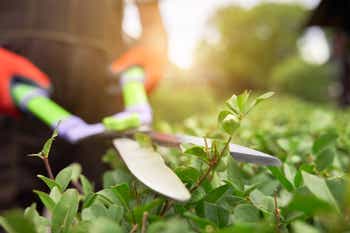U.S. residents in dry regions know that wildfires can occur at any time when temperatures rise, humidity drops and destructive winds combine to increase the risk of brush and forest fire. Wildfires can be devastating—causing serious damage to your property and threatening personal safety. That’s why advance preparation is essential if you want to protect your family, pets and home from these devastating firestorms. So, here are a few tips on how to prepare for a wildfire.
Wildfire Preparation: What to do before a fire?
-
Establish and maintain a safe zone around your house that will act as a fire break. Firescape your home and surrounding structures with low-growing, fire retardant and fire resistant plants. Your local nursery can suggest a combination of attractive, water-wise plant materials that will help to reduce your home's vulnerability. Different zones around your property will require various management efforts and differing plant life to perform optimally, including plant removal/replanting, managing weeds, maintaining efficient irrigation, caring for hedges, and managing terraces. In addition to routine maintenance, look for plants that have thick, large and broad leaves (rather than needles or blade-like leaves) that are moist and easily bent, without a fragrance – these are less likely to ignite. Replace plants that are old or unhealthy, as they pose a greater fire risk.
-
Retrofit your home with non-flammable building materials. Roofs should be constructed of non-combustible, "Class A" fire-resistant material. Exterior windows should be dual-paned tempered glass. Exterior walls should be finished with fire-resistant materials such as stucco, stone or brick. Although easy to maintain, vinyl siding can melt in a fire and is not recommended.
- Clean roof surfaces, gutters and eaves of leaves, pine needles and branches regularly to avoid accumulation of flammable materials.
- Install spark arresters in chimneys and install one-quarter inch, non-combustible screens in all vent or eave openings.
- Keep trees and shrubs pruned and remove dead or dying trees and plant materials. Stagger planting of trees to create a barrier to intercept and help prevent wind-driven burning material from reaching your home. Prune branches that are near or overhang the roof. Remove lower tree branches below six feet from the ground, and maintain a vegetation-free zone beneath the tree's drip line.
- Store flammable liquids properly and away from occupied buildings. Propane tanks should be located 50 feet from structures, and valves should be turned off if there is a danger of fire. The tank area should be clear of flammable vegetation and combustible materials.
- All combustibles, such as firewood, picnic tables, boats, etc., should be located at least 50 feet from your home and other structures.
- Maintain landscaping around your home. Using fire-safe materials, creating ample workspace for firefighters and clearing an exit route for evacuation can protect you and your home.
- Make sure your street address is visible from the street.
What to do during a wildfire
Wildfires are unpredictable and can strike at any moment, making it essential for homeowners to be well-prepared to protect their lives and property. Consider the following steps to stay prepared:
- Stay informed: Regularly tune in to news broadcasts and weather updates to stay informed about the latest developments, evacuation instructions, and red flag warnings.
- Prepare your vehicle: Position your car in an open area for a quick escape. Fuel your vehicle and ensure it’s in good driving condition.
- Make a plan for your pets: Gather and confine them to a single room or area that’s easily accessible. Ensure they have enough food, water, and medications for an extended stay.
- Wear protective clothing: This attire includes long-sleeved shirts, long pants, sturdy shoes, gloves, and a face mask to shield yourself against smoke and flying embers.
- Be ready to evacuate immediately: Keep important documents, medications, identification, and a first-aid kit in a readily accessible bag. If authorities recommend evacuation, leave immediately and don’t delay.
Emergency preparedness kits - What to take to an evacuation center
The American Red Cross offers these suggestions from former evacuees about items to include in an emergency preparedness kit.
- Comfortable clothing, such as sweats, and sturdy shoes
- Medications for the family and pets
- Personal items, such as family pictures, favorite books, iPod and cell phone with chargers, and your bed pillow
- Snack food
- Cash (small bills and coins)
- Insurance paperwork and contact information
- Cell phone chargers
Homeowners with property located in rural areas or communities adjacent to open space have a greater risk of damage during a wildfire. If fire officials declare an evacuation—and time permits—homeowners should take these safety precautions prior to departing.
- Turn off gas and pilot lights.
- Turn on a light in every room.
- Move combustible patio furniture inside, and relocate flammable furniture away from windows and sliding glass doors.
- Connect garden hoses to outside faucets.
- Hose down rooftops and the outside of your home.
- Lock your home.
- Follow the designated evacuation route.
Filing a claim
Claims can be reported to Mercury's Claims Hotline 24 hours a day, seven days a week by calling (800) 503-3724. Learn more by reading our fire insurance claims guide.
Mercury Insurance offers wildfire mitigation discounts to California homeowners living in wildfire prone regions. Homeowners who take one or more wildfire prevention steps to harden their homes or live in a community recognized by the National Fire Protection Association® (NFPA) as a Firewise USA® site will be eligible to receive discounts of up to 18% on their homeowners insurance in California. For more information about protecting your family, pets and property from violent and deadly firestorms, read Mercury’s FAQ Guide, facts about wildfires, and how wildfires start blogs. Be sure to also visit these websites:


